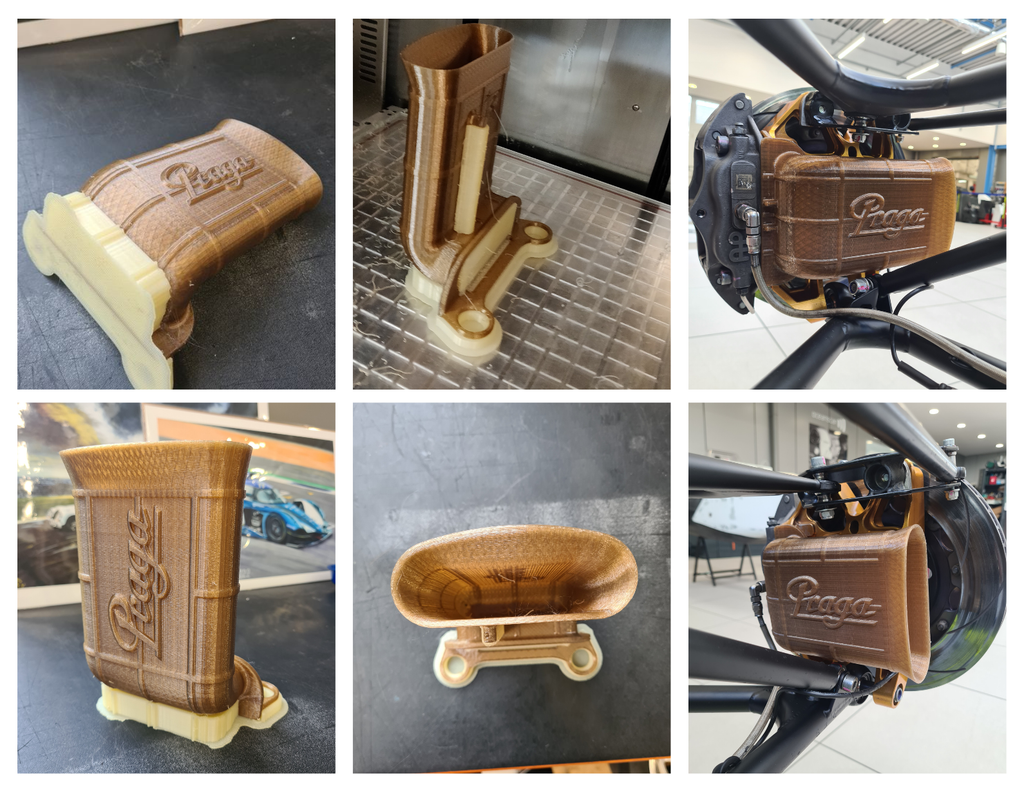Company Highlight:
The University of Wolverhampton provides an education in all disciplines of Engineering from Foundation degree to Masters level, with a dedicated Engineering Campus at its Telford Innovation Campus in Priorslee. The University has specific Motorsport and Automotive courses along with all other disciplines of Engineering including Aerospace, Mechanical and Manufacturing to name a few. These courses are complimented by the in-house racing team (UWR) University of Wolverhampton Racing. This outlet not only provides Industry experience in these fields at track and in the workshop, but aims to deliver real world scenarios to support the theory learnt in the class room.
“Evo3D’s support with this project has been invaluable. Their sponsorship through UWR has provided the opportunity to work with industry leading equipment within the additive manufacturing field, not only providing support and training, but the prospect of working with high end materials such as PEEK which has enabled us at the University to apply our designs to real world applications."
- Ewan Bishop – Third Year BEng Motorsport Engineering Student and UWR Senior Team Leader.
The Challenge:
- Praga R1T – Competing in the Praga Cup 2022 (First year for UWR with our new car)
- Initial impression – Brake Sensitivity to Temperature
Dry conditions with 57 to 60% front bias for performance set-up the front brakes were overheating – Indicated by the green/orange/red temperature indicator paint applied to disc vents which was blowing the red to white
Green paint : Turns to White at 430°C.
Orange paint : Turns to Yellow at 560°C.
Red paint : Turns to White at 610°C.
- Brake efficiency is reduced and does not perform to the best of its ability, requiring brake bias to be moved back between 50 to 55%, thus changing the driving characteristics of the car for the drivers – performance reduced.
- Pad/disc life and condition further supported the brake temperature issues along with thermal IR temperature gun readings.
To combat this challenge UWR needed to investigate ways to reduce the high brake temperatures as seen, and alleviate any disadvantages placed on the front braking system specifically. It is common practice to duct air from the front of the vehicle towards the braking components to lower operating temperatures – with the Praga packaging and design is crucial to not disturb airflow over aerodynamic devices and the area beside the wheels.
The Approach:
- Traditional product design criteria, follow the brief and specification to come up with various design ideas.
- Measure/scan the environment to reverse engineer the product from conception.
- Produce a CAD design through iterations to test.
- Rapid prototype designs using PLA to test fit.
- Real world application prototype.
- Analyse the conditions and product after tests to evaluate the suitability.
- Once proven design manufacture using high end FDM manufacturing process on the 3DGence F420 in a suitable material.
To design and manufacture a very specific and one off component through the CAD modelling process FDM printing was the most suitable approach to take. Access to 3D printing equipment reinforced this decision, but more so the fact that it is possible to produce more complicated and intricate one off components to a high standard which would be more difficult and costly to achieve with other manufacturing techniques. In the first instance prototyping in PLA material allows for a fast and cost effective method of producing physical components to test and evaluate to design specifications, before committing to manufacturing using a higher costing material.
The Solution:
- Rapid prototype designs using PLA to test fit. (in-situ on the vehicle)
- Real world application prototype final design in PA12-CF15
(This was to test the conditions, temperatures and strength of the material to see if the FDM process could withstand the design brief and specifications.)
- Analyse the conditions and product after tests to evaluate the suitability
- Once proven design manufacture using high end FDM manufacturing process on the 3DGence F420 in PEEK Filament.
The solution to the problem was to produce a quality and high-end looking component that was in keeping with the Praga Aesthetics. This component needed to not only function as a brake duct, allowing air to be directed towards the brake components, but also be manufactured to be lightweight and strong, easily removed and quickly but secure to function in harsh operating environments. The design would allow the duct to be held between the brake caliper and the upright through location, opposed to a physical mount. The front of the duct would involve a redesign of the existing ABS sensor mount in order to locate and pin the duct using an R-Clip for quick and easy removal.
The aim was to bring the temperatures recorded down by at least 100 degrees so that the red indicator paint was not blowing and the orange paint was either still showing or on the verge of turning yellow, thus allowing better braking efficiency for performance and prolonging the life of items.
The Results:
- The working prototype in PA12-CF15 survived in operation across two test days and a race weekend, consisting of two qualifying sessions and two hour long races.
- The left brake duct only showed signs of minor deformation around one of the mounting rings – melting/softening of a sliver edge – however did not effect the operation of the component.
This demonstrates that even in close proximity pass through temperatures are between 150 to 180 degrees to cause the previous deformation.
- Front brake bias was able to be maintained 60%
- The temperature indicator paint on the front did not blow the red to white as previously with temperatures reduced.
- Component wear reduced.
The design purpose and functionality have been proven, demonstrating a clear improvement. The PA12-CF15 verified that it could perform the task from a material perspective, however it is bordering on the temperature limit. After prolonged use this could signal a failure point around the rear mounts, further testing would need to be undertaken to calculate the life of the part in hours, however it could be a suitable replacement material.
Following on from the success of the working prototype and considering the information gathered in operation, the next step was to produce a final product using a higher end material – thus PEEK was chosen as it was appropriate for the application in terms of strength and temperature resistance, but also giving the University the opportunity to work with higher temperature filaments and gain valuable experience in terms of the set-up of the F420 from lower temperature procedures to high temperature manufacturing.
The Project:
The aims of this project were:
- To manufacture concept brake duct components from in house designs to trial and ultimately use.
- To learn and operate the F420 3DGence FDM Printer to further experience and understanding of high temperature printing with industry standard equipment to produce quality components in different materials.
UWR comprises of various racing team activities in an educational environment, and at the forefront of this is learning current and new techniques. Evo3D helped the team by furthering our ability to manufacture components in house. Having access to 3DGence equipment enabled the team to move into areas not yet attempted, specifically high temperature FDM printing. The F420 gave us the opportunity to experiment with this project.
The F420 was a step up for the team from the equipment currently used in house and it was clear to see how industry standard equipment makes the task so much simpler and refined for the users.
Costs:
3DGENCE PEEK (250g) £142 per Roll (80m) (186g of filament used to produce a single duct.)
3DGENCE ESM-10 Support material £192 per Roll (1 Kg) ( (93g of filament used to produce single duct.)
3DGENCE VXL-EX Support dissolver £29.66
Printing Time – 28 h 9 min Ave Power Consumption @ 1.5 kWh (42.25 kW)
PA12-CF15 £44.30 per Roll (500g)
(384g of filament used to produce two ducts and two ABS mounts.)
Printing Time – 23 h 59 min Ave Power Consumption @ 1.5 kWh (36 kW)
PLA £15 per Roll (1 Kg) (1200g of filament used during prototyping designs)
X2 Rolls
Printing Time (Combined) – 150 h Ave Power Consumption @ 1.5 kWh (225 kW)
About 3DGENCE
The ongoing focus on our customers’ everyday challenges
In 2014, we began a vision and a commitment to make the most versatile, flexible, and cost-effective industrial 3D printing solutions that will support and optimize the workflow of our customers. With headquarters both in the Americas and Europe and our partners worldwide, we are providing global coverage and services to our customers across the world.
Engineer your NOW and inspire the FUTURE of the industry with us having your back.
The partner you can trust
We are a part of MS Galleon AG, one of the biggest capital groups in the CEE region belongs to Michał Sołowow. With the support, we had an opportunity of introducing our 3D printing technology and now we provide customers with advanced 3D printers with extensive industry experience, influencing the development of industrial companies.
What drives our work is the urge to provide customers with technologically best, industry-ready, and reliable products and services.
We manufacture our technology
The INDUSTRY line 3D printers are manufactured in our production plants. The team of experienced engineers focus on developing the best solutions that enable producing end-use parts, functional prototypes, and metal replacement parts in real-time with the most advanced materials available today.



